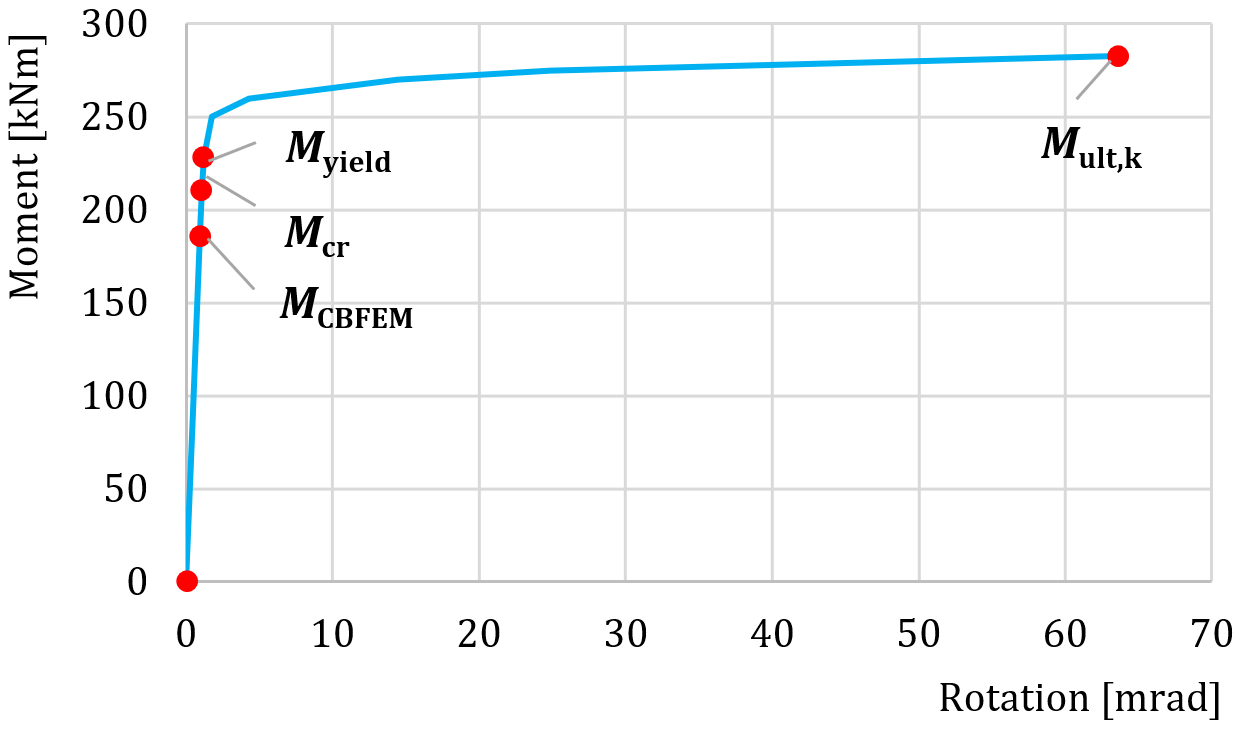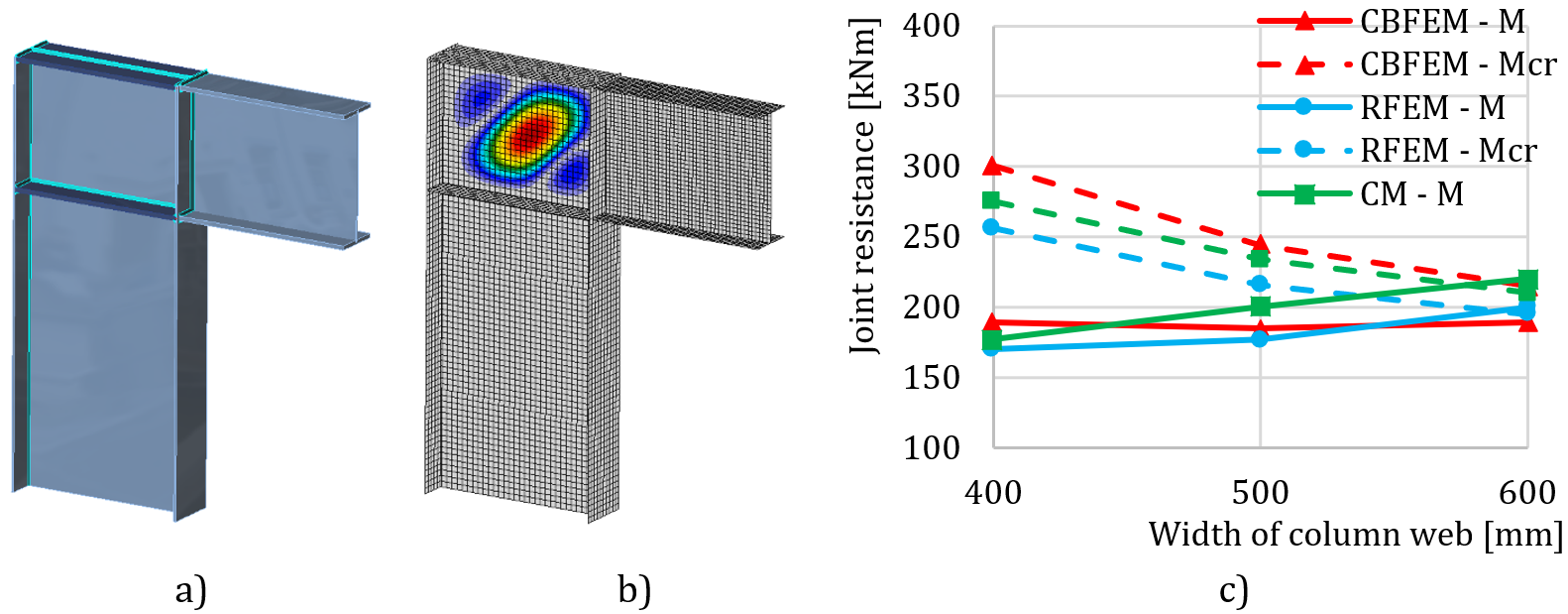Description
The objective of this study is verification of component-based finite element method (CBFEM) of a beam-column joint with a class 4 column web with a research FEM model (RFEM) and component method (CM).
Analytical model
The component column web panel in shear is described in cl. 6.2.6.1 in EN 1993-1-8:2005. The design method is limited to column web slenderness d / tw ≤ 69 ε. Webs with higher slenderness are designed according to EN 1993-1-5:2006 cl. 5 and Annex A. The shear resistance is made of shear buckling resistance of the web panel and resistance of the frame made of the flanges and stiffeners surrounding the panel. The buckling resistance of the web panel is based on the shear critical stress
\[ \tau_{cr} = k_{\tau} \sigma_E \]
where σE is the Euler critical stress of the plate
\[ \sigma_E = \frac{\pi^2 E}{12 (1-\nu^2)} \left ( \frac{t_w}{h_w} \right )^2 \]
The buckling coefficient kτ is obtained in EN 1993-1-5:2006, Annex A.3.
The slenderness of the web panel is
\[ \bar{\lambda_w} = 0.76 \sqrt{\frac{f_{yw}}{\tau_{cr}}} \]
The reduction factor χw may be obtained in EN 1993-1-5:2006 cl. 5.3.
The shear buckling resistance of the web panel is
\[ V_{bw,Rd} = \frac{\chi_w f_{yw} h_w t_w}{\sqrt{3} \gamma_{M1}} \]
The resistance of the frame may be designed according to cl. 6.2.6.1 in EN 1993-1-8:2005.
Research FEM model
Research FEM model (RFEM) is used to verify the CBFEM model. In the numerical model, 4-node quadrilateral shell elements with nodes at its corners are applied. Geometrically and materially nonlinear analysis with imperfections (GMNIA) is applied. Equivalent geometric imperfections are derived from the first buckling mode, and the imperfection amplitude is set according to EN 1993-1-5:2006, Annex C. A numerical model is shown in Fig. 6.2.1.
Fig. 6.2.1 Research FEM model of a beam-column joint with slender column panel
Design finite element model
The design procedure for slender plates is described in section 3.10. The linear buckling analysis is implemented in the software. The calculation of the design resistances is done according to the design procedure. FCBFEM is interpolated by the user until ρ ∙ αult,k/γM1 is equal to 1.
A beam-column joint with a slender column web is studied. The height of the beam web is changing; thus, the width of the column web panel is changing. The geometry of the examples is described in Tab. 6.2.1. The joint is loaded by bending moment.
Tab. 6.2.1 Examples overview
| Example | Column flange | Column web | Beam | Material | ||
| bf | tf | hw | tw | IPE | ||
| [mm] | [mm] | [mm] | [mm] | |||
| IPE400 | 250 | 10 | 820 | 4 | 400 | S235 |
| IPE500 | 250 | 10 | 820 | 4 | 500 | S235 |
| IPE600 | 250 | 10 | 820 | 4 | 600 | S235 |
Fig. 6.2.2 Moment-rotation curve of example IPE600 (Kuříková et al. 2019)
Global behavior and verification
The global behavior of a beam-column joint with a slender column web described by moment-rotation diagram in CBFEM model is shown in Fig. 6.2.2. Attention is focused on the main characteristics: design resistance and critical load. The diagram is completed with a point where yielding starts and resistance by 5 % plastic strain.
Verification of resistance
The design resistance calculated by CBFEM is compared with RFEM and CM. The comparison is focused on the design resistance and critical load. The results are ordered in Tab. 6.2.2. The diagram in Fig. 6.2.3c shows the influence of the width of the column web on the resistances and critical loads in the examined examples.
Tab. 6.2.2 Design resistances and critical loads of RFEM, CBFEM, and CM
| Example | Mcr | αcr | M | αult,k | Difference | |||||
| RFEM | CM | CBFEM | CBFEM | RFEM | CM | CBFEM | CBFEM | MCBFEM / MRFEM | MCBFEM / MCM | |
| [kNm] | [kNm] | [kNm] | [-] | [kNm] | [kNm] | [kNm] | [-] | [%] | [%] | |
| IPE400 | 256 | 275 | 301 | 1,59 | 170 | 177 | 189 | 1 | 1,11 | 1,07 |
| IPE500 | 216 | 234 | 244 | 1,32 | 177 | 200 | 185 | 1,28 | 1,05 | 0,93 |
| IPE600 | 195 | 210 | 215 | 1,14 | 200 | 220 | 189 | 1,51 | 0,95 | 0,86 |
The results show good agreement in critical load and design resistance. The CBFEM model of the joint with a beam IPE600 is shown in Fig. 6.2.3a. The first buckling mode of the joint is shown in Fig. 6.2.3b.
Fig. 6.2.3 a) CBFEM model b) First buckling mode c) Influence of width of column web on resistances and critical loads
Verification studies confirmed the accuracy of the CBFEM model for the prediction of a column web panel behavior. The results of CBFEM are compared with the results of the RFEM and CM. The design procedure is verified on the RFEM model. Procedures predict similar global behavior of the joint.
Benchmark example
Inputs
Beam
- Steel S235
- IPE600
Column
- Steel S235
- Flange thickness tf = 10 mm
- Flange width bf = 250 mm
- Web thickness tw = 4 mm
- Web height hw = 800 mm
- Section height h = 820 mm
- Overlap over top of the beam 20 mm
Web stiffener
- Steel S235
- Stiffener thickness tw = 19 mm
- Stiffener width hw = 250 mm
- Welds aw,stiff = 7 mm
- Stiffeners opposite to upper and lower flange
Code setup – Model and mesh
- Number of elements on biggest member web or flange 24
Outputs
- Load by 5 % plastic strain Mult,k = 285 kNm
- Design resistance MCBFEM = 189 kNm
- Critical buckling factor (for M = 189 kNm) αcr = 1,14
- Load factor by 5 % plastic strain αult,k = Mult,k / MCBFEM = 285/189 = 1,51
References
EN 1993-1-5, Eurocode 3, Design of steel structures – Part 1-5: Plated Structural Elements, CEN, Brussels, 2005.
EN 1993-1-8, Eurocode 3, Design of steel structures – Part 1-8: Design of joints, CEN, Brussels, 2005.
Kuříková M., Wald F., Kabeláč J. Design of slender compressed plates in structural steel joints by component based finite element method, in SDSS 2019: International Colloquium on Stability and Ductility of Steel Structures, Prague, 2019.


